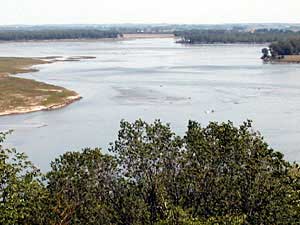|
Audio
Photos
More from MPR
|
April 12, 2005
Western South Dakota is in the fifth year of a drought and the water levels on the Missouri River are 30 feet below normal. That's why the U.S. Army Corps of Engineers may make some big decisions this year that could include shortening the navigation season for commercial barges. The corps is holding a series of meetings this week in communities along the river.
Sioux Falls, S.D. — For years, the battle's been the same -- upstream versus downstream. Resort owners want more water upstream along the Missouri River. But in downstream states, commercial navigation needs the water.
Bruce Peterson owns a resort on Lake Oahe, the largest of the reservoir lakes created by damming the Missouri River. He tries to remain optimistic, saying he has more beach property than he thought.
Peterson is also optimistic because it's been raining for the past few days. He says it's the first measurable precipitation he's seen since last fall. He wants more water to remain upstream especially this year.
"I believe that in the past there's been some water that's been misused. I don't want to use the word wasted, but misused," says Peterson. "Now people are starting to realize the value of holding back some water. The lakes up here are getting critically low, to where the production of electricity is going to start being impacted as well, plus the water for cities."
Dozens of communities rely on the Missouri River for drinking water. For one Indian reservation, it's the only source of water. This may be the summer the Cheyenne River Indian Reservation runs out of water. Officials will release a plan with several options and their costs next month.
Paul Johnston, spokesman for the U.S. Army Corps of Engineers, says the Corps is looking at ways to keep all sides happy. But it won't be without sacrifice.
"We are going to be shortening the navigation season a little bit more than we anticipated. But we'll know exactly what that shortening is on the first of July, when we do a storage check," says Johnston. "What's magic about July 1 is that's when we normally have the majority of the mountain snow that has melted in the reservoir."
Johnston says the Corps will also change its policy by holding water back upstream if downstream areas get rain.
"If we continue to get rain in eastern South Dakota and downstream, then we will be able to cut those releases. And we're really hoping that we'll be able to maintain steady reservoir levels at Lake Oahe during the fish spawn this year," says Johnston.
Oahe is an important part of the river's multi-million dollar fishing industry. The South Dakota Game, Fish and Parks Department says the drought makes it difficult for anglers to have access to the river. The state spent $3 million to extend boating ramps over the past three years, but many ramps still aren't long enough to reach the water.
The state needs to spend another $1 million to extend the ramps even farther this year. The state of South Dakota is responsible for all of the recreation areas along the river.
Resort owner Bruce Peterson says about one-third of the docks on Oahe are open. He says anglers can get on the river, but they need to know where to go. He says he's most concerned about the elderly and handicapped fishermen.
"They have to walk up the hill to park their cars," says Peterson. "We were talking about that at a meeting the other day, and I believe they're going to do what they can to help with that situation. Have midway parking on some of these ramps that are long."
Peterson says he knows the Missouri River basin is in a drought cycle that can't last forever. He says, though, that it'll take many years for the river level to get back to normal.







